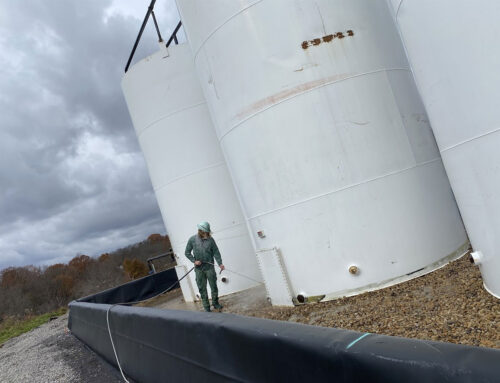Properly preparing steel surfaces for industrial coatings is an important part of the process. This ensures that the coatings adhere and perform as intended, protecting steel surfaces from corrosion and other wear and tear.
Steel is one of the most important metals in industrial facilities. Alone, it is durable, hard and strong. It can be enhanced with various industrial coatings to increase its strength, durability and resistance to corrosion and abrasion.
Benefits of adding these coatings to steel include improving its resistance to rust and oxidation, resistance to abrasion, improving its performance when it comes to harsh chemicals and can make it easier and safer to handle. Coatings can also be used to improve the appearance of industrial surfaces.
In order to reap the benefits from these coatings, steel surface preparation must be completed to get the steel ready to be coated. Proper surface preparation is an important part of ensuring an industrial coating performs properly.
Types of Steel Surface Preparation
Before we get into the key steps of surface preparation, it is important to understand the different types of surface preparation and techniques that can be used on steel. It is important to note that these techniques should only be used by a professional industrial painting contractor, as they can be dangerous or can damage equipment if done improperly.
Abrasive blasting
This is one of the most popular, quick and cost-effective ways to prep a steel surface. Abrasive blasting can be used to remove rust, old paint and mill scale from large areas. However, abrasive blasting will not remove grease or chemicals.
Another type of abrasion that can be used is wet abrasion, which uses pressurized water to remove contaminants. However, wet abrasive blasting can only remove water-soluble substances. It may cause flash rusting, but this can be avoided using a rust preventer.
Hand tool cleaning
Hand tool cleaning is used for parts of a surface that cannot be reached with other methods, such as with small corners, seams or crevices. Tools such as sandpaper, brushes, chisels, scrapers and more can be used to help remove substances from steel.
Power tool cleaning
Power tools can be used instead of hand tools to clean small areas that are not easy to reach. They can save a lot of time when used in place of hand tools. However, in some cases, very small areas and crevices will still need to be prepped by hand.
Typical power tools can be used to chip away at rust and paint. It is important to use these tools carefully and properly, as improper use can damage the surface.
Remember, leaving steel surface preparation to a professional industrial painting contractor will ensure the job is done properly, without damaging any equipment.
Things to Consider When Preparing Steel Surfaces
Remember, surface preparation is used to remove any contaminants from a surface that is to be coated or painted. Proper surface preparation ensures that all coatings used will adhere properly to the surface, which, in turn, will ensure the industrial coating performs properly.
- Determine if Pre-Cleaning is Necessary
In many cases, pre-cleaning the surface is necessary before surface preparation can occur. Cleaning is necessary if there are any surface contaminants, or visible oil, grease, or dirt. Pre-cleaning removes any grease, oil or other chemicals that may be present on the surface.
If the surface is in a high-salt area, thorough pre-cleaning is always necessary before other methods, such as abrasive blasting, can be used. Even a small amount of salt or dust leftover can greatly impact how a coating will adhere.
- Determine the Appropriate Method of Cleaning
As outlined above, there are multiple ways to prepare a steel surface. Abrasive blasting is great for cleaning large areas, but will not remove chemicals or oily substances such as grease – these will require a harsher abrasive to remove.
Wet abrasion is best used in situations where there is a lot of dust. In addition, other abrasive materials can be mixed with the pressurized water to fit the job. Wet abrasion is great for removing thick coatings.
For smaller, hard to reach areas, hand tools and power tools should be used to manually clean and prepare the surface.
- Check if the Surface is Prepared Properly for Coating
After the surface is prepped, your contractor will inspect the surface to ensure it was prepared properly. After the surface meets the preparation requirements, primer can be applied and the coating process may begin.
In Summary
Properly preparing steel for a protective industrial coating will ensure the coating adheres and works properly. Remember, steel surface preparation is best left to the professionals, such as our contractors at Eagle Eye Services.
Ready to Get Started?
Have questions about your project or need a quote? We’ve got someone ready to help you.



